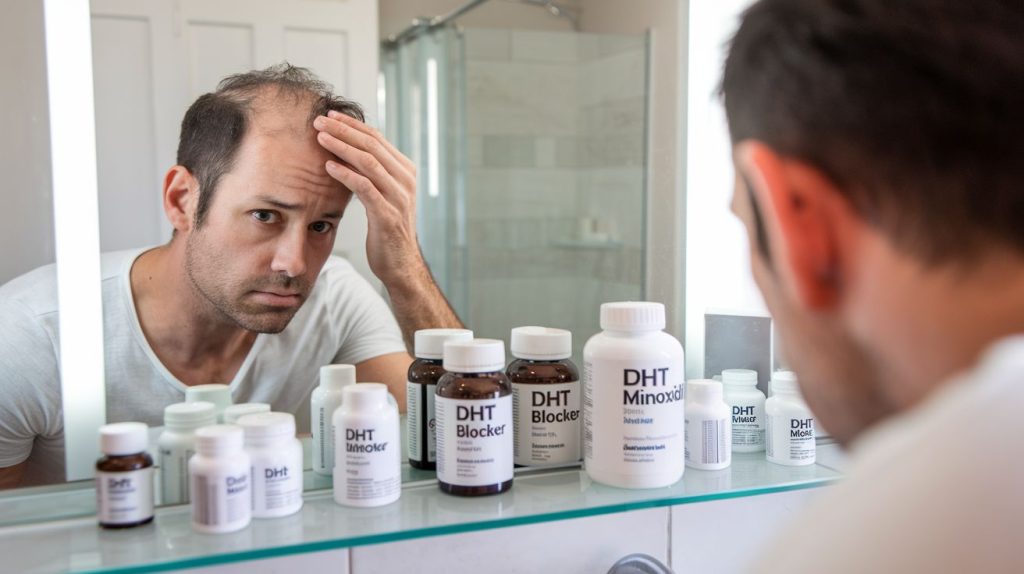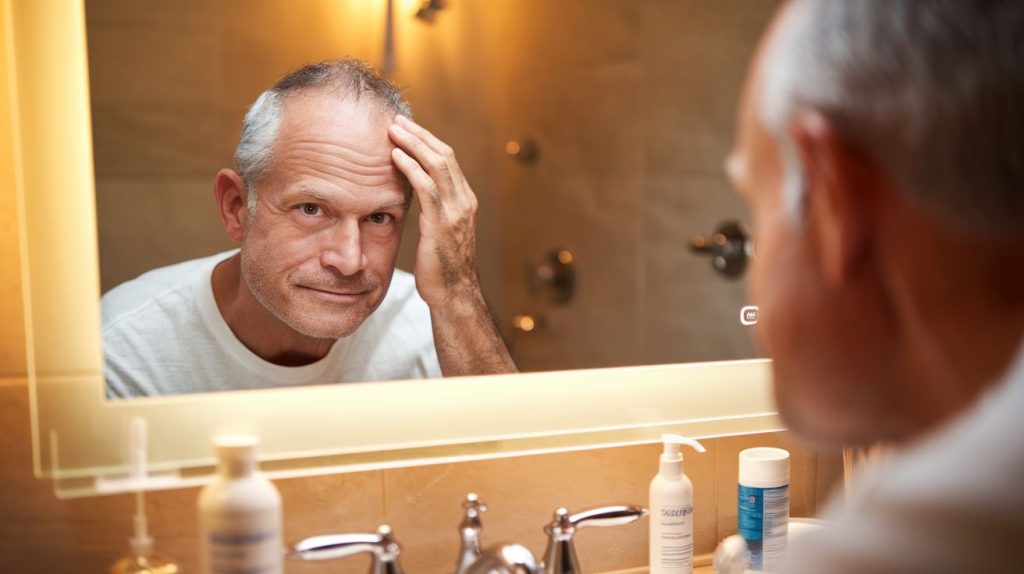Are you noticing more hair on your pillow or in the shower drain? 😱 Does your hairline seem to be creeping back, or is your crown looking a little sparse? If you’re a man experiencing these symptoms, you might be facing the most common form of hair loss: male pattern baldness.
For many men, the prospect of losing their hair can be distressing. It’s not just about vanity – hair loss can impact self-esteem, social interactions, and even career prospects. But here’s the good news: understanding male pattern baldness is the first step towards taking control of your hair health. 💪
In this comprehensive guide, we’ll dive deep into the world of male pattern baldness. From its causes and stages to diagnosis and treatment options, we’ll cover everything you need to know. Whether you’re just starting to notice changes in your hair or you’re well into your hair loss journey, this post will equip you with the knowledge to make informed decisions about your locks. Let’s unravel the mystery of male pattern baldness together!
What is Male Pattern Baldness?
Definition and prevalence
Male pattern baldness, scientifically known as androgenetic alopecia, is the most common form of hair loss in men. It affects approximately 50% of men over the age of 50 and can begin as early as the late teens or early twenties. This condition is characterized by a specific pattern of progressive hair loss, typically starting at the temples and crown of the head.
Common signs and symptoms
The primary signs of male pattern baldness include:
- Receding hairline, often in an M-shape
- Thinning hair on the crown
- Gradual loss of hair density
| Area Affected | Early Stage | Advanced Stage |
|---|---|---|
| Hairline | Slight recession | Significant M-shaped recession |
| Crown | Minor thinning | Noticeable bald spot |
| Overall | Subtle changes | Visible hair loss pattern |
Typical age of onset
While male pattern baldness can begin at any age after puberty, it’s most commonly observed:
- In the late 20s or early 30s for many men
- By age 35, approximately 40% of men show some degree of hair loss
- By age 50, about 50% of men are affected
- In rare cases, it can start in the late teens
Differences from other types of hair loss
Male pattern baldness differs from other forms of hair loss in several ways:
- Pattern: Follows a predictable pattern, unlike patchy or total hair loss
- Cause: Primarily genetic and hormonal, not due to external factors
- Progression: Typically gradual, not sudden or rapid
- Permanence: Without treatment, hair loss is generally permanent
Understanding these characteristics helps distinguish male pattern baldness from temporary or reversible forms of hair loss, guiding appropriate treatment strategies.
Causes of Male Pattern Baldness
Genetic factors
Male pattern baldness, also known as androgenetic alopecia, has a strong genetic component. The inheritance pattern is complex, involving multiple genes. Research suggests that the AR gene, which provides instructions for making the androgen receptor protein, plays a crucial role in this condition.
| Gene | Function | Impact on Male Pattern Baldness |
|---|---|---|
| AR | Androgen receptor | Affects hair follicle sensitivity |
| EDA2R | Ectodysplasin A2 receptor | Influences hair growth cycle |
| TARDBP | TAR DNA-binding protein | Associated with early-onset baldness |
Hormonal influences
Hormones, particularly dihydrotestosterone (DHT), significantly contribute to male pattern baldness. DHT is derived from testosterone through the action of the enzyme 5-alpha reductase. In genetically predisposed individuals, DHT:
- Binds to androgen receptors in hair follicles
- Shrinks hair follicles over time
- Shortens the growth phase of the hair cycle
Age-related changes
As men age, several factors contribute to the progression of male pattern baldness:
- Decreased cell regeneration in hair follicles
- Reduced blood flow to the scalp
- Cumulative effects of hormonal influences
- Gradual thinning of hair shafts
Environmental contributors
While genetics and hormones are primary factors, certain environmental elements can exacerbate male pattern baldness:
- Stress: Chronic stress can accelerate hair loss
- Diet: Nutritional deficiencies may impact hair health
- Medications: Some drugs can induce or worsen hair loss
- Lifestyle factors: Smoking and excessive alcohol consumption may contribute
Understanding these causes is crucial for developing effective treatment strategies and managing expectations for those affected by male pattern baldness. Next, we’ll explore the various stages of this condition to help individuals identify where they are in the progression of hair loss.
Stages of Male Pattern Baldness
Norwood-Hamilton Scale explained
The Norwood-Hamilton Scale is the gold standard for classifying male pattern baldness progression. This scale consists of seven stages, each representing a different level of hair loss severity.
| Stage | Description |
|---|---|
| I | No visible hair loss |
| II | Slight recession of the hairline |
| III | Noticeable recession at temples |
| IV | Severe recession and thinning on crown |
| V | Larger balding areas, but still separated |
| VI | Balding areas merge, with only a horseshoe of hair remaining |
| VII | Most extensive hair loss, only a narrow band of hair remains |
Understanding this scale helps both patients and healthcare providers track the progression of male pattern baldness and determine appropriate treatment options.
Early signs to watch for
Early detection is crucial for effective management of male pattern baldness. Some initial signs include:
- Gradual thinning at the crown
- Receding hairline, especially at the temples
- Increased hair shedding during washing or styling
- Widening of the part line
Progressive thinning patterns
As male pattern baldness advances, distinct thinning patterns emerge:
- Frontal thinning: Hair loss starts at the forehead and gradually moves backward
- Crown thinning: Balding begins at the top of the head and expands outward
- General thinning: Overall reduction in hair density across the scalp
These patterns often combine as the condition progresses, leading to more extensive hair loss. Understanding these stages and patterns is essential for early intervention and effective treatment planning.
Diagnosis and Assessment
Physical examination techniques
Physical examination is crucial in diagnosing male pattern baldness. Dermatologists typically employ several techniques to assess the extent and pattern of hair loss:
- Visual inspection
- Hair pull test
- Dermoscopy
- Scalp photography
The hair pull test involves gently tugging on a small section of hair to determine the number of hairs that come loose. Dermoscopy uses a specialized magnifying tool to examine the scalp and hair follicles in detail.
| Technique | Purpose | Advantages |
|---|---|---|
| Visual inspection | Assess overall pattern | Quick and non-invasive |
| Hair pull test | Evaluate active shedding | Simple and informative |
| Dermoscopy | Examine follicles closely | Highly detailed analysis |
| Scalp photography | Track progression over time | Objective comparison |
Scalp biopsy: when is it necessary?
While rare in diagnosing male pattern baldness, a scalp biopsy may be performed when:
- The cause of hair loss is unclear
- Other conditions are suspected
- There’s rapid or patchy hair loss
This procedure involves removing a small sample of scalp tissue for microscopic examination. It can help differentiate between various types of alopecia and rule out underlying scalp conditions.
Ruling out other causes of hair loss
Before confirming male pattern baldness, it’s essential to exclude other potential causes of hair loss. Doctors consider factors such as:
- Medical history
- Medications
- Nutritional deficiencies
- Hormonal imbalances
- Autoimmune disorders
Blood tests may be ordered to check for thyroid dysfunction, iron deficiency, or hormonal issues. Additionally, a thorough review of the patient’s lifestyle, stress levels, and family history helps paint a comprehensive picture.
Now that we’ve covered the diagnostic process, let’s explore the various treatment options available for male pattern baldness.
Treatment Options
A. Medications (Minoxidil, Finasteride)
When it comes to treating male pattern baldness, medications are often the first line of defense. Two FDA-approved options stand out:
- Minoxidil:
- Topical solution applied directly to the scalp
- Available over-the-counter
- Stimulates hair follicles and prolongs the growth phase
- Finasteride:
- Oral medication taken daily
- Prescription required
- Blocks the conversion of testosterone to DHT
| Medication | How it works | Effectiveness | Side effects |
|---|---|---|---|
| Minoxidil | Increases blood flow to hair follicles | Moderate | Scalp irritation, unwanted facial hair growth |
| Finasteride | Reduces DHT levels | High | Decreased libido, erectile dysfunction (rare) |
B. Hair transplant surgery
For those seeking a more permanent solution, hair transplant surgery offers promising results. This procedure involves:
- Removing hair follicles from areas with thicker growth
- Transplanting these follicles to balding areas
- Two main techniques: Follicular Unit Transplantation (FUT) and Follicular Unit Extraction (FUE)
C. Scalp micropigmentation
This non-surgical option involves:
- Tattooing pigment into the scalp
- Creating the appearance of a fuller head of hair
- Ideal for those with extensive hair loss or who prefer a shaved look
D. Low-level laser therapy
An emerging treatment that:
- Uses red light to stimulate hair follicles
- Can be done at home with specialized devices
- Shows promise in clinical studies, but more research is needed
E. Natural remedies and supplements
While scientific evidence is limited, some men explore natural options such as:
- Saw palmetto
- Pumpkin seed oil
- Biotin supplements
- Scalp massage and essential oils
It’s important to consult with a healthcare professional before starting any treatment regimen for male pattern baldness. They can help determine the most effective approach based on individual factors and the extent of hair loss.
Living with Male Pattern Baldness
Psychological impact
Male pattern baldness can significantly affect a person’s mental well-being. Many men experience:
- Decreased self-esteem
- Anxiety in social situations
- Depression
- Body image issues
Studies show that hair loss can lead to a 75% decrease in self-confidence. It’s crucial to address these psychological impacts proactively.
Styling tips for thinning hair
Effective styling can help manage the appearance of thinning hair:
- Keep hair short and textured
- Try a buzz cut or shaved head
- Use volumizing products
- Experiment with hair fibers or concealers
| Hairstyle | Benefit |
|---|---|
| Buzz cut | Low maintenance, modern look |
| Textured crop | Adds volume, disguises thinning |
| Comb-over | Covers bald spots strategically |
Building confidence and self-acceptance
Accepting hair loss is a journey. To build confidence:
- Focus on personal strengths and achievements
- Practice positive self-talk
- Engage in activities that boost self-esteem
- Consider counseling or therapy if needed
Support groups and resources
Connecting with others can be invaluable. Resources include:
- Online forums (e.g., Reddit’s r/tressless)
- Local support groups
- Hair loss organizations (e.g., American Hair Loss Association)
- Educational websites and blogs
These resources offer emotional support, practical advice, and up-to-date information on managing male pattern baldness.
Now that we’ve explored living with male pattern baldness, let’s look at some strategies for prevention.
Prevention Strategies

Early intervention benefits
Early intervention is crucial in managing male pattern baldness effectively. By addressing the issue at its onset, individuals can:
- Slow down hair loss progression
- Maintain existing hair density
- Improve treatment outcomes
- Boost self-confidence
Here’s a comparison of early vs. late intervention:
| Aspect | Early Intervention | Late Intervention |
|---|---|---|
| Hair retention | Higher chance | Lower chance |
| Treatment options | More diverse | Limited |
| Cost-effectiveness | Generally lower | Often higher |
| Psychological impact | Less severe | More severe |
Lifestyle changes to promote hair health
Making certain lifestyle adjustments can significantly impact hair health:
- Balanced diet rich in:
- Proteins
- Vitamins (especially B-complex)
- Minerals (iron, zinc)
- Stress management through:
- Regular exercise
- Meditation
- Adequate sleep
- Avoiding harmful habits:
- Smoking
- Excessive alcohol consumption
Regular scalp care routines
Implementing a consistent scalp care regimen can help maintain a healthy environment for hair growth:
- Use gentle, sulfate-free shampoos
- Massage scalp regularly to improve blood circulation
- Avoid excessive heat styling
- Protect hair from UV damage with hats or hair products with SPF
By incorporating these prevention strategies, individuals can potentially delay the onset or progression of male pattern baldness. While genetics play a significant role, these proactive measures can contribute to overall hair health and potentially improve treatment outcomes if needed in the future.
Future of Male Pattern Baldness Treatment
Emerging therapies and research
The future of male pattern baldness treatment looks promising, with several innovative approaches on the horizon. Researchers are exploring novel therapies that target the root causes of hair loss, offering hope for more effective and long-lasting solutions.
| Therapy | Description | Potential Benefits |
|---|---|---|
| Stem Cell Treatment | Uses stem cells to regenerate hair follicles | Natural-looking results, potential for permanent solution |
| PRP Therapy | Utilizes platelet-rich plasma to stimulate hair growth | Minimally invasive, uses patient’s own blood |
| Exosome Therapy | Employs cell-derived vesicles to promote hair regrowth | May enhance existing treatments, potential for standalone therapy |
Gene therapy possibilities
Gene therapy represents a groundbreaking approach to treating male pattern baldness. Scientists are investigating ways to:
- Modify genes responsible for DHT sensitivity
- Enhance expression of hair growth-promoting genes
- Silence genes that contribute to follicle miniaturization
This targeted approach could potentially offer a permanent solution to male pattern baldness by addressing the genetic roots of the condition.
Advancements in hair cloning
Hair cloning, also known as hair multiplication, is an exciting frontier in male pattern baldness treatment. This technique involves:
- Extracting healthy hair follicles
- Multiplying them in a laboratory setting
- Reimplanting the cloned follicles into balding areas
While still in experimental stages, hair cloning could revolutionize hair restoration by providing an unlimited source of transplantable hair. As research progresses, we may see significant improvements in the efficacy and accessibility of this innovative treatment option.

Male pattern baldness is a common condition that affects millions of men worldwide. By understanding its causes, stages, and available treatment options, individuals can make informed decisions about managing their hair loss. From genetic factors to hormonal influences, recognizing the underlying mechanisms empowers those experiencing male pattern baldness to take proactive steps.
Whether opting for medical interventions, lifestyle changes, or embracing baldness as a personal style, it’s essential to approach hair loss with a positive mindset. Remember that male pattern baldness does not define one’s worth or attractiveness. By staying informed about emerging treatments and maintaining overall health, individuals can navigate this natural process with confidence and grace.




